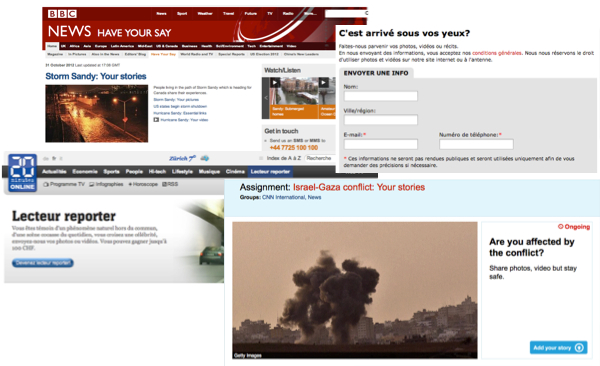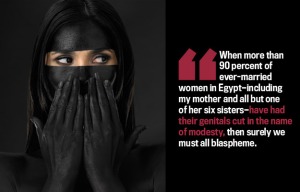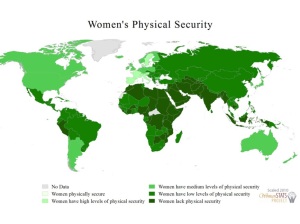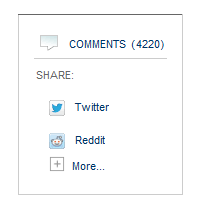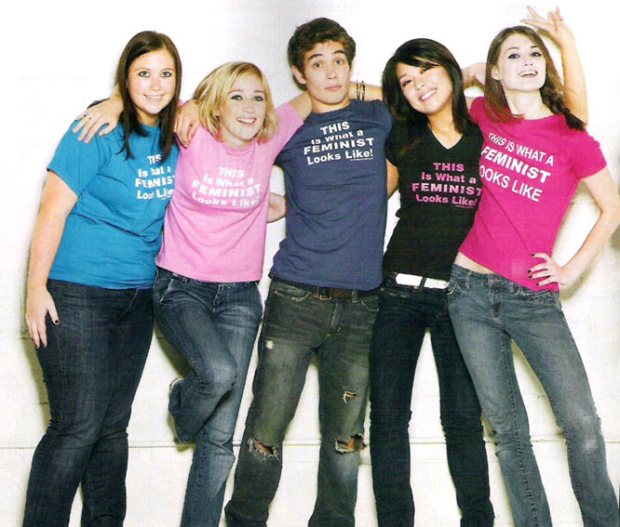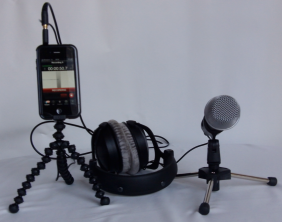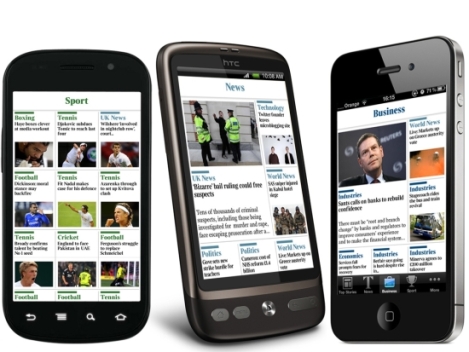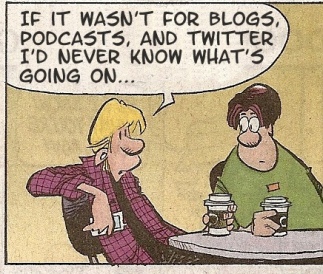Posts Tagged journalism
Watching TV on two screens
Posted by francoisvermot in Technology on November 27, 2012
Because one screen is not enough, even more people don’t only watch TV passively anymore. Laptop on the knees, it became normal to surf on the web while watching intermittently TV.
Nowadays, the so-called Second Screen applications appear on our tablets, giving additional informations linked with the TV’s main program. Useful ?
A familiy watching religiously at TV in the 50’s. Past times. Nowadays, one screen is not enough anymore.
http://i.dailymail.co.uk/i/pix/2009/10/31/article-1224231-0706B500000005DC-601_634x512.jpg
http://sociable.co/wp-content/uploads/2012/09/second-screen-vizio-tv-ipad3-750×375.jpg
What does the Second Screen brings to us viewers ?
The second screen provides additional informations, in link with what you’re watching on your TV. An international example are the 2012 London Olympics, an event during witch several main TVs transmitted content about the results of the athletes during the broadcasting on the Second Screen.
The Guardian Second Screen, on tablet
Second Screen experiences in Switzerland
A swiss example : the RTS “deuxième écran”
In February 2012, the Radio Télévision Suisse launch its own Second Screen system. Up to now, only one program uses the application : the daily evening news “19:30”. During the program, each time a report is broadcasted, complements become available on the application.
Lets have a look at how it works :
From the RTS website mainpage “deuxième écran” section can be found in “Les plus du web”
Or, it’s possible to acess to it directly following this link.
How does the RTS “deuxième écran” looked like for today’s 19:30 ?

Want to know more about Christian Varone topic ? The second screen gives you more elements.
The second screen doesn’t only proposes texts, but also graphics (for the elections periods for example), videos, pictures galleries, and all wich supports the web can provide.
A video made by the RTS about the “deuxième écran” at the moment of it’s launch :
http://www.rts.ch/video/emissions/grand-angle/3956695-le-deuxieme-ecran-du-19h30.html
Playing with Second Screen
In December, the RTS will launch it’s new general culture game “Les Imbattables”.
The game itself isn’t very innovative (teams composed by a kid and a senior try to answer questions in a quiz). What’s new is the possibility for the viewer to answer actively to the questions on a tablet, trough the Second Screen. As the question is displayed on the TV screen, it appears also on the tablet with the possibility to answer to it.
RTS future game “Les Imbattables” will use since December 2012 the Second Screen technology.
Usefull, the Second Screen ?
Looking at the swiss example of the 19:30 “Deuxième écran”, it certainly provides some additional informations. The graphics are for example interesting, since they appear quite quickly on TV, sometimes too fast to be analysed properly.
But it appears that most of the content of this RTS Second Screen remains quite light, with just short texts, and the videos simply come from the swiss television website. There are no additional videos coming from youtube or dailymotion, no links : nothing that can really bring the user to new way of knowledge.
The Second Screen is but quite a new born. Some time more should be needed in order to see the concept further developed in the future. The TV broadcasters believe in the future of this technology. As does for example David Wertheimer, president of digital at Fox :
The second screen discussion we’ve been having is just one piece of a strategy that’s all about giving our audiences an opportunity to talk about the shows and share thoughts with the showrunners and the talent. To us, that’s what television in the 21st century is all about.
From : http://edition.cnn.com/2012/09/15/showbiz/tv/second-screen-tv-our-mobile-society/index.html
David Wertheimer, president of digital at Fox, believes in the future of the Second Screen.
http://www.adweek.com/files/news_article/first-mover-david-wertheimer-hed-2012.jpg?1345387748
And you,
Are you using Second Screen ? Or do you want to stay an oldschool « couch potatoe » ?
Before Second Screen: couch potatoes. What’s the best ?
http://narcoosseefl.com/wp-content/uploads/2010/12/couch-potato-kid.jpg
Can anybody be a journalist?
Posted by romainbardet in Uncategorized on November 27, 2012
Who can be called a journalist? The answer isn’t so easy, but so important in a world where everything goes so fast and information has a great impact on human activities.
Today, almost anybody in the world has a smartphone and an access to the web. Anybody can post a picture, a text or a video and give a sort of information to the world. How? With the new media: Blogs, Facebook, Twitter, Wikipedia or YouTube. Information is so easy and so quickly widespread trough the planet. “Great evolution”, will say the ones. “Disinformation” will respond the others.

Will the professional journalists disappear?
Picture: macalester.edu
The raise of citizen journalism: the new world’s voice
People don’t want to stay silent. For many centuries, journalists have been people’s voices. They found, collected and verified the information and always searched for the truth. But with the Internet’s democratization, people don’t want to wait that the journalists let them speak. They prefer to raise their voice directly and explain or show something to the whole world.
With the advent of Internet 2.0, new media technologies, for example social networking and media-sharing websites, gave citizens the opportunity to give information. Those citizen journalists often report breaking news faster than “normal” journalists. We can cite the events of Arab Spring, which were a lot report by anonymous citizens in the heart of the revolution. Another example of this quick report and exchange of information is the “Occupy Wall Street” movement which debuted on September 17th 2011.

Syrian activists send information with their computer.
Picture: bbc.co.uk
A really actual example is Syrian crisis. The country is closed and inhospitable for the journalists. But Syrian people who live the war post videos and testimonies on YouTube, social media or blogs. They claim their story and give a reality that many journalists just can’t report. It benefits to the citizens in the world, to realize what’s happening there!
Chris Shaw, the editorial director of ITN, a Britannic production society, said to The Guardian that social networks were opening up “whole new vistas for documentary filmmakers. You can make the most amazing films using content from social networks, sometimes with the permission and sometimes without the permission of the people who shot them.”
This reality takes all its sense with the Syrian crisis. “There are places like Syria where journalists haven’t been able to go and […] there is an extraordinary resource on social networks for current affairs, even though we have to take extraordinary caution to verify what we use”, said Chris Shaw.
Let’s see a short funny video, but with interesting points of reflection. “No no, I’m the journalist!”:
Let people participate
What we can observe today, is that many classical media websites give people the possibility to react and deepen the information. You can let comments in the website’s blog for example. Professional journalists are not alone anymore, because readers give a feedback and let them know what they think about the article and more globally about the topic.
Other media are based on the concept that citizens can contribute to the news by giving information or sharing links, but with the control and the work of professional journalists behind. This is the case of Digital Journal or Rue89 in France for example. But is it citizen journalism? I don’t think so. We can call this hybrid journalism, because citizens and professional journalists work together.
 But some websites or blogs are entirely “citizen made”. You, I, anybody can add an article and participate to information’s transmission. But these platforms ask the contributors to share valuable and verified information, and grant themselves the right to remove an inappropriate content. For example, we can mention the Quebec’s website centpapiers or the better known Wikinews.
But some websites or blogs are entirely “citizen made”. You, I, anybody can add an article and participate to information’s transmission. But these platforms ask the contributors to share valuable and verified information, and grant themselves the right to remove an inappropriate content. For example, we can mention the Quebec’s website centpapiers or the better known Wikinews.
American information’s channel CNN launched in 2008 its new participative site: CNN iReport. This website is only based on citizens content. They can post a story, picture, commentary or video and create the news. What is interesting with this concept is that CNN’s journalists sometimes select a subject and diffuse it on the classic channels. With this system, citizens can really be a part of the media agenda setting.
Citizens, yes! Citizen journalists, no!
So where is the difference between a citizen and a professional journalist? Well, let’s go back to the very base of journalism: giving information. Information isn’t just a concept; it’s the reality, the truth, what’s really happening. Yes, journalism is “making information” and transmitting this information to the people; a full-time job!
Here are some answer people gave to the question “Who should be called a journalist?” on ijnet (international journalist’s network):

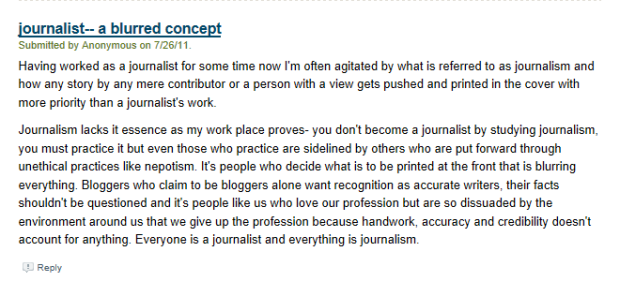

If we set aside the fact that professional journalists work for a media and are paid for this, we must consider that journalists respond to some exigencies and rules. They have to verify the sources, analyze them, explain the events, replace them in their context and be as objective as possible. And the journalists must respect deontological rules. Do the citizen journalists respect those exigencies? Because they must, instead we just can’t call them journalists.
Another point is that a professional journalist isn’t in the commentary when he writes an article. When a citizen journalist writes, we often observe committed comments. Professional journalist informs, when online citizen testifies to what he sees, ears or notices.
But today, citizens contribution is a wealth for journalists. An inexhaustible source of ideas and materials than can be used. And it forces journalists to do their job: treat information and not only transmit it as it is. Citizens make their citizen’s job, when they transmit something important and newsworthy to the journalists.
You’re a citizen, a journalist, or maybe a citizen journalist: what do you think? Leave you comments!
Crowdsourcing: how is this concept applied to journalism?
Posted by celinebilardo in Technology on November 27, 2012
With the rise of the Web 2.0, more and more people get to express themselves on the Internet: by contributing to a personal blog, answering to a poll on a website or making comments on any event the web is talking about. Today, those contributions can be neatly managed by news organisations to make you participate to their news production. And this is the object of this blog’s entry: crowdsourcing the news.
The crowd likes to be involved
Jeff Howe is the man who coined the term “crowdsourcing” in 2006 in an article called “The Rise of crowdsourcing.” At the time he was a contributing editor of the Wired magazine. Now he tends to be perceived as The Crowdsourcing expert. But you may wonder…
What is crowdsourcing?
As Jeff Howe well expressed it, crowdsourcing is a process of involving the public, the crowd, into a task by an open call. And this process if often made through a website. The definition could include many sorts of calls, indeed. To a large extent, crowdsourcing can be applied to solving a scientific problem, as the company InnoCentive started to do in 2001, or as IStockphotos managed in outsourcing the task of photographing an event to a voluntary crowd instead of hiring a professional photographer for instance.
Crowdsourcing takes many forms. But one thing makes it unique: it empowers the crowd. As the crowd represents different brains, different competences, it can be even more creative, efficient, innovative and influent than a single man working in his office on a task he has no grasp into.
How news organisations make the most of it?
In the context of Journalism, you can well imagine that the journalist and the news organisation one can work for were primarily the only gatekeepers of news, and you were waiting for them to be informed. If there was a place for you to communicate with the newspaper, there was the “letters to the editor”, and not many more.
Today news organisations have their websites. Moreover, if you give a closer look to them, you will notice they even make a space for you to act and communicate. Not by solely adding comments. There is more!
In England, the BBC has launched Have your Say ; in the USA, CNN opened iReport. And the Swiss news organisations are not the last: The RTS has Vos infos and The 20minutes has the Lecteur-Reporter’s platform. All fell in the new trend. They all let you the chance to be part of their work, or in other words: now the news need you.
As a million of events happen across the world, reporters and journalists cannot cover them all. This is where the audience is powerful: it can improve their coverage.
When terrorists set off a series of bombs on buses and subways in London, who produced the most riveting images and sound bites? The passengers and their cell phones.” [1] When an accident occur next to your home, or on your way to work, you are the first witness of the event and no professional reporter could catch the same tension you were able to grasp when it happens.
With a single photo, a video, a short message, you can make a newsroom get up. You can even make it change its editorial agenda.
For Bernard Rappaz, Editor in chief at the RTS in Switzerland, crowdsourcing makes a news media quicker than before. Using Twitter, Facebook, and their crowdsourcing tool on their website, the members of the newsroom can compete with the news agencies they are sometimes dependent on. As Mathieu Coutaz confirms himself: it allows the staff to be the first on the scene and to be always closer to the stories that interest the people their work for.
Mathieu Coutaz is the content manager for 20minutes online in the French-speaking part of Switzerland. The 20minutes is The daily newspaper distributed in Switzerland and this, for free. Its platform “lecteur-reporteur” has been launched in 2006 and the newspaper rewards any contributions that it eventually publishes on its web. What is most, “50% to 70% of the contributions that are selected go on the print edition” Mathieu Coutaz explains. And he emphasises one fundamental point that cannot be neglected: your photos and stories go through a process of verification before getting anything done. “When verified, the contributions of the audience can influence the editorial agenda on the temporal and hierarchical aspects. If it has to be treated before another news, and if the story is worth being published at the top of our agenda, then of course we do it.”
For the one that may want to ask: But isn’t it citizen journalism? In fact, no it isn’t. Robert Niles states this argument in his “Journalist’s guide to crowdsourcing”:
Crowdsourcing does not ask readers to become anything more than what they’ve always been: eyewitness to their daily lives.
In that sense the news organisations save their first role of gatekeepers: the readers don’t write the stories, they only contribute to it: the final decision of its treatement and broadcast still lies in the professional’s hands.
Crowdsourcing at risks
In an interesting article, Darren Gilbert warns that “crowdsourcing can be as advantageous as it can be dangerous.” Although readers are willing to contribute to the news, some are able to get a journalist on the wrong track. He takes the example of a recent scandal that occurred in the United States: a company named Journatic published news gathered from the public. And there were actually wrong!
In Switzerland, all the news platforms I discovered ask for the name and mail address of the contributors, in order to be able to get back to him/her. A mail address can be fake, indeed, but in any case, Swiss news organsations do the verification before publishing, which can avoid some serious faux pas.
To cope it all, crowdsourcing may well bring the public and the news organisation closer than before. It may establish a new relationship between the public and the news media: a trust that could have been lost. But it still needs to be well used in order not to lose what crowdsourcing is for journalism: a relevant tool to make the crowd part of the work, for a better and substantial result.
I am now turning to you
Have you ever contributed to the news of your local newspaper?
What do you think of the crowdsourcing concept regarding journalism?
And to go further…
A new trend in crowdsourcing is for journalists to use special crowdsourcing platforms to gather the information they couldn’t find from their places, such as Ushahidi‘s platform, specialised in mapping crowdsourcing information.
The TED talks also got into the crowdsourcing concept, here is a talk held by Paul Lewis about the impact of crowdsourcing the news for investigative journalism.
And to be always up to date with the last seminars about crowdsourcing and journalism, have a look at the European Journalism Center’s website, it’s worth it!
By Céline Bilardo
[1] Howe, J. 2008. Crowdsourcing: Why the power of the crowd is driving the future of business. 1st ed. USA: Ed.Crown Business. p.212.
Internet : A voice to feminist journalists
Posted by fsator in Uncategorized on November 26, 2012
Internet definitely changed feminism. You don’t need to be Simone de Beauvoir or some kind of Jeanne d’Arc to be a feminist writer.
If before women were struggling to defend their rights, today the situation is completely different. It is way simpler to sit behind our screen to write and post our opinion on gender inequality.
February 1971; Swiss women have the right to vote. Thanks to hundreds of women who fought for it finally a women has a voice. But that doesn’t mean inequality collapsed. Not at all. Women continued to fight for a lot of other things (abortion for example) in very different ways (riots, books, add…). Until internet appeared… Feminist had a new wide range of communication. Thankfully internet is a good guy, it doesn’t make any distinction. Let’s face it ; internet opened new doors for us. I thought it would be interesting to see those new communication tools, internet offered to feminist. What would feminism have looked like without internet? Surely not like this…
 Websites as a voice for feminism:
Websites as a voice for feminism:
Feminism is not about shouting “men are jerks, women are better”.
Mona Eltahawy, a feminist journalist, fears an autumn for women after the Arab Spring. She uses internet to post article on a foreign policy website to reveal the conditions of women in the Arab world. All right we already knew that women weren’t treated like this:
In her article “why do they hate us”, Mona Eltahawy denounces
“Until the rage shifts from the oppressors in our presidential palaces to the oppressors on our streets and in our homes, our revolution has not even begun”
No doubt that without internet her article would never have been published in an Arab country.
I can’t imagine this picture in the Egyptian libraries or walls:
On the same website we can also look at a map where we can discover the countries where it is less secure to be a women:
If it wasn’t on internet, this map wouldn’t have been published in a book or maybe in some of them. But as we can see there are no countries where women are considered physically secured.
But Mona Elhatawy article and those maps brought many feedbacks on social networks. As we can see here is how the articles have been commented:
A very encouraging result…
Blogs: Another voice to feminism
All right, you don’t work for a huge online newspaper. That is fine; internet permits you to have a…blog!
And there are so many blogs, so many feminist writing about their experiences or expressing their opinion that making a selection was really hard.
But I managed to rank those blogs by preference:
– Feministing:  Yes feminist but also actual! It is like reading your newspaper in a feminine version. For example on the 14th of November, America is talking about the “women triangle” that shook the CIA. Well feministing is going to give you the other version “a CIA director who cheated on his wife”. And not the other version, “the women who disturbed CIA”
Yes feminist but also actual! It is like reading your newspaper in a feminine version. For example on the 14th of November, America is talking about the “women triangle” that shook the CIA. Well feministing is going to give you the other version “a CIA director who cheated on his wife”. And not the other version, “the women who disturbed CIA”
Yes Feministing is definitely a blog to read in the morning while taking your breakfast.
– Echnide of the snake: what a weird name for a blog. The blogger started it in 2003 and it mainly reflects what happen every day in the women world. For example we discover an article about an Irish woman who died after being denied abortion.
– Viedemeuf:  “chick life” in English, is a blog written by every woman who witnessed a sexist event or something that surprised her in her life. Owned by the group “osez le feminsime” it gives the opportunity to citizens to rule the blog. For example Helen, a blogger, says:
“chick life” in English, is a blog written by every woman who witnessed a sexist event or something that surprised her in her life. Owned by the group “osez le feminsime” it gives the opportunity to citizens to rule the blog. For example Helen, a blogger, says:
Today in Walt Disney’s bathroom I saw a man cleaning his baby; why are they baby equipment only in women’s bathroom?
This was just an extract among every other blogs you can find. Feminist journalism exists, but also anti-feminism journalism. But I am not going to give you any links…I am not going to do any advertisement for the enemy!
Videos : 3 minutes to say “yes to feminism”.
The good thing about a video it is that you can hear people talking, see them acting and get the message easily.
It might be easier to be funny through a video than a text… Not for everybody of course but a group of young people succeed at being very funny through their videos.
It came from a simple idea: what if we exchanged our roles? Let’s put a woman in the shoes of a man for 2 minutes, make her act like a man and see what it looks like. Well the result is pretty hilarious. Judge by yourself:
“Osez le feminism”, in English “dare feminism” are hundreds of feminist militants who come together to fight for women rights. Videos are just a small part of their work; they have a serious website, with serious event and serious people.
Pictures: A simple and quick voice to feminism
Ever wondered what a feminist looked like?
Or
I bet you want to have the same! Here is a website where you can buy it: The feminist T-shirt
Let’s take a look at another kind of pictures:
Some of them are worth a thousand words.
Sixteen women of Professor Rachel Seidman’s Women in the Public Sphere course at Duke University decided to put words and pictures together. On their blog Who needs feminism.
They post pictures of people from all over the world who explains why they need feminism for.
Children, man, woman, from all generations come all together to say why feminism is important.
Here are some pictures:
Social networking: the newest voice to feminism
Twitter, facebook ect… who didn’t hear about it? If you are not on twitter or facebook that is fine, but if you don’t know what the hell we are talking about, I am going to ask you “how are you reading this from Mars?!”.
And those tools are definitely excellent tools to spread a message.
The facebook group “Feminism” and”feminist frequency” organizes events, and tells us all about feminism and women in the world. “Liking” one of these pages allows all your facebook friends to know that you are feminist or like what the group does.
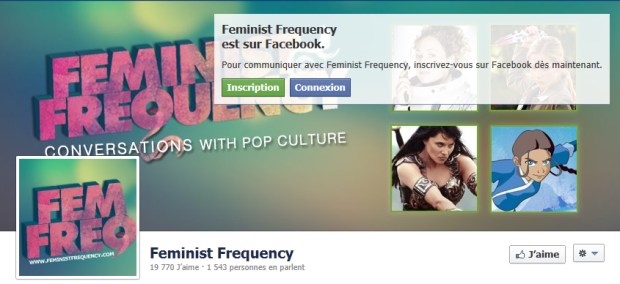 And we have feminist twists that we can follow! “Feminist” hulk is an amazing feminist twitter profile that I love to follow because it is hard not to laught!
And we have feminist twists that we can follow! “Feminist” hulk is an amazing feminist twitter profile that I love to follow because it is hard not to laught!
Thanks to twitter feminism is now following you!
*We need feminism to do our duty as women, mothers, employees or simply for not being judged…we don’t need to be perfect (translation of the twitt)
If after all this you think that they are not enough messages and expression for feminism, I don’t know what to add to convince you. We can’t deny that internet changed the way we live. Everyone has a voice. The only thing you need is a computer and the wifi.
Dear internet, Mozilla, google, facebook, twitter ect… thank you for being awesome feminist friends!
Tutorial: the use of social networks (Twitter and Facebook) as a journalist
Posted by guillaume35 in Entertainment, Technology on November 26, 2012
Both Twitter and Facebook cannot be ignored any more when talking about the World Wide Web. Thus are they surely to be considered when using the amazing internet tool as a journalist. Let’s now have a look at how to get the best of it!
Guillaume Laurent
The social networks, by the number of subscribers they gather, are a rich source of information, as well as an amazing showcase. Therefore, it can be used by journalists in a number of ways: to always be aware of what is going on and interesting people, to try to get people to give their opinion about a subject, to get some feedbacks about an article, or to extend one’s readership and number of followers. In the interest of being more accurate, I’ll focus here only on the use of Twitter and Facebook Here are the few tips you will need to be an efficient social network journalist!
Three things to know when using social networks as a source
1- Verification must without contest be your main concern when using social networks as a source. If social networks can often be much quicker than traditional Medias to provide a story, they cannot be trusted, and the journalist must look around to see if other users or legitimate sources providers can confirm the story.
2- You have to develop your own trusted network within social Medias. Getting the wider choice among a group of users you now are trustworthy is a powerful asset for a journalist using social networks.
3- You must be systematic when using social Medias as a source. By doing the same ritual times and times again, you will gain a more accurate judgment about what is said on social networks, and thereafter win a lot in efficiency.
Three things to know when using social networks to gather opinions
1- Think about your personal experience on social networks. In which circumstances would you give your opinion? Which kind of question would you actually answer and which kind you wouldn’t? It will give you a valuable clue to guess how to manage your audience and get the best of it.
2- Before looking after opinions, you have to decide if you want to get a number based statistic answer or rather a few interesting witnesses. You will get more answers with a question that can be answered only by “yes” or “no”, but an open question will often give you more information to deal with.
3- Create a debate. To give their opinion about a specific subject, people must feel concerned, disturbed, annoyed or enthusiasm. Therefore you should give a direction to your question, give something of yourself to push your followers to react. .
Three things to know when using social networks to get some feedbacks about one’s articles
1- Getting a lot of feedbacks can be dangerous for your website. If you want to advertise using social networks you will have to be ready to assume de consequences. I mean managing properly de comments posted on your page or website. Otherwise, spamming or provocative answers will quickly suffocate the debate.
2- Before advertising on social networks, you must be aware that everything you will post, included answers to readers, comments or random posts, will be considered as a part of your work and evaluated and criticize in this sense. There for having separates account for your private life and your job can be very useful.
3- Post pictures and videos to get attention. Even if your work is mainly based on writing, you will have to use pictures and videos. It will surely get you more feedback, and images are what modern internet journalism is all about.
Three things to know when using social networks to extend one’s readership
1- “Tweet your beat”, the advice was given by Lauren Invik, from the social medias specialized website marshable.com. If you want to get some authority on social networks and bring in something more than the millions of other users, you have to be a specialist. That means tweeting or publishing on Facebook only when you know exactly what you are talking about. Giving your opinion on random subjects is not a plan for a good social networks journalist.

2- Being a specialist also includes being among the first to get the news about your favorite subject. Therefore is it necessary to give to your audience more than your own stories. Using in a wise way the retweet or share opportunity will help you a lot while trying to please your followers and make your account attractive.
3- Link as much as possible your publications. The hashtag and the “@” button are crucial not only to reach a wider public, but also to show your sources and make your information safe and valuable. Websites like tagboard.com are based on the use of the “@” and de hashtag and often used by people to look for news about a specific subject.
So, fellow journalists, have you already been using successfully social Medias in your work? Would you add some advices to the previous shortlist? This article is meant to be updated and enhanced by your contribution!
To become a perfect social Media journalist: more advices with this Youtube vidéo from BeatBlogging.Org
More on the subject with this France 2 TV show about Twitter brodcasted in 2010
Facebook as a journalistic tool
Posted by emilienasel in Technology on November 25, 2012
Facebook is becoming an increasingly popular tool in media circles opening up a wide scope of new interactivity. Let’s take a look at how journalists use this social network as a part of their work.
My parents have often said that Facebook is useless. Well, they couldn’t be more wrong! Since its launch in 2004, more and more journalists use it as a professional tool. Through profiles and pages that I have looked at, I analyzed how journalists use Facebook.
Two uses for the journalists
Firstly a very valuable journalistic use of this social network is crowdsourcing. Many journalists seek interaction with the public by asking their fans for their opinion on current issues. This enables them to get large numbers of answers in record time. One of the most active journalists in the field is probably Nicholas Kristof, columnist for The New York Times, who posts articles or news links several times a week while asking his reader to give their opinion.
 |
 |
While browsing on Facebook, it is obvious that news is everywhere. The interaction of the users within the social network allows journalists to find which topics of interest or concern attract people. David Abiker, a radio columnist at France Info, confirmed in an interview for journ@lism.info: “Sometimes, my friends offer me news or a buzz to treat. In this case, Facebook can become a source of information. Facebook allows you to see how people react to new items.” (Read the entire interview here.)
Secondly, Facebook is very useful when looking for testimonies. This practice ca be observed in different countries. In Switzerland, Darius Rochebin, a RTS journalist, is very active on his account: “Facebook is valuable when we are trying to find a testimony. Links can be made between Facebook friends and potential witnesses.”
In France, David Abiker also uses this method:
“Facebook allows me to find experts or witnesses. So when I need a particular guest, I post something like this: “David Abiker is looking for a sports psychologist”, or “David Abiker is looking for an Internet specialist”, and it works pretty well.“
In the United States, Lisa Eckelbecker, a reporter for the Worcester Telegram & Gazette, also uses Facebook to search for testimonies: “Recently, I asked my Massachusetts friends if they could help me find sources for a story on supermarket retailing.“
Facebook is a very useful tool in journalism because it is a huge time-saver when it comes to looking for evidence. Darius Rochebin explains: “What used to take two or three hours, now takes only few minutes. Before, it was often necessary to make dozens of phone calls to reach the person you wanted. Now, thanks to mutual friends, in a few clicks you can find what you are looking for.“
Mark Zuckerberg is now friend with journalists
If journalists are now becoming increasingly aware of the potential that Facebook offers them in their work, Mark Zuckerberg’s team has been developing a strategy to attract more journalists since 2011. In April 2011, the social network launched its page “Journalists on Facebook“. The purpose of this page was to make Facebook more popular with journalists, in particular with a search engine of sources.
(Video of Mashable with Vadim Lavrusik, journalism program manager at Facebook)
In the meantime, Facebook launched a survey among journalists giving rise to five elements encouraging them to use Facebook more efficiently :
- Posts which include questions lead to an increase of “like” of 15%.
- Posts with a photo or a link collect 50% of more “likes”.
- Internet users comment more frequently posts published on Thursday, Fridays, Saturdays and Sundays, in the early morning (between 7am and 8am), at the end of the day or late in the evening.
- Personal thoughts included in the publication generate a higher click rate than a classical post.
- Topics about education, politics or journalistic analysis get more feedback than others.
(Read the entire conclusions of the survey here.)
To conclude, my parents were indeed wrong: Facebook can be useful in some areas. Mark Zuckerberg’s site has now became essential for most journalists. Even Darius Rochebin admits:
“In my opinion, journalists who refuse to use Facebook are making a big mistake. Personally, I could not do without it, it has become an absolute necessity.“
But, will Facebook, like Twitter, gradually become a site for professionals rather than for private users?
The role of Online Journalism for the 20 Minutes and how it uses Facebook and Twitter.
Posted by alizeeliechti in Technology on November 24, 2012
As the German version of the website www.20mn.ch became a reference and became one of the most consulted and well-known websites in Switzerland, I wanted to know whether the same would occur in the French part of the country. The aim of this article is thus to analyse the French version of the news website and to explain how the journalists use social media (Facebook and Twitter) to promote articles.
 20 Minutes Online is an information platform. It is probably one of the most effective, efficient and powerful portals of news in Switzerland. It covers three parts of Switzerland according to the languages (20 Minuten for German, 20 Minuti for Italian and 20 Minutes for French). In this article, I will focus only on the French version, which was created on the 8th of March 2006.
20 Minutes Online is an information platform. It is probably one of the most effective, efficient and powerful portals of news in Switzerland. It covers three parts of Switzerland according to the languages (20 Minuten for German, 20 Minuti for Italian and 20 Minutes for French). In this article, I will focus only on the French version, which was created on the 8th of March 2006.
The success of 20 Minutes Online is mostly due to the speed with which news is added. There were 1’035’000 articles written for the sole month of February ; this illustrates how the website is constantly increasing. Each section possess a Facebook and/or a Twitter account on which it shares almost instantaneously posts with the link to the relevant article. All the posts are linked to the website www.20min.ch/ro. Is the activity of sharing news on social medias a good way to reach a wide range of readers and redirect them to the initial platform 20 Minutes ?
The opinion of the expert

Mathieu Coutaz is the « head » of the site. He explains that only most relevant news is posted on Twitter and Facebook ; it represents between 5% and 10% of the overall production. Some sections are more active than others on social media : « News, Sports and People are the rubrics which post the most. The reason is that we are first a news website and therefore we are making a lot of news articles », confirms Mathieu Coutaz. Of course, the idea to share content on social media brings new readers. « Sharing news is for the 20 Minutes both appreciated and practical. 4% of our traffic comes from Facebook and less than 0,1% from Twitter. Google remains the most important marketing online tool », concludes the person in charge of the website.
Analysis
By observing the different Facebook and Twitter accouts, it’s easy to determine that the news item is the most active. Being an online webiste which brings news means to be the first to tell a story or relate an event.

On Facebook, 9 sections possess an account (News, Cinema, Football, Hockey, Sports, Festivals & Music, Insolite, Hitech and People). Twitter is a little bit less popular with only 7 items (Buzz, HiTech, Music, News, People, Sports, Gamezone).
To poursuive , each section manages its own page on the social media. Hereunder are two examples coming from the People page and Online page :
The organisation of the Facebook and Twitter accounts permit people to react or to share posts.
Survey
I questioned 30 people about their consumption of the news from the 20 Minutes via Facebook or Twitter. For this survey I used Facebook in order to distribue the survey’s link.
The results show that people who live in Romandie are not fond of information. 45% admit they don’t follow the news, 21% say they follw information on Facebook only and 21 % on Twitter. Only 14% admit they follow news on both social media. To conclude, people are not yet used to follow news on the Internet, but nowadays a lot of website become more and more active on social media to promote, share and comment on news.
Conclusion
Regarding the « semestrial report » of Tamedia dated June 2012, the website 20Minutes Online is the number one with 3’673 thousand unique clients per month. How long will it keep this so conveted first place ? Are newspapers online associated with social media the future of Journalism ? Nowadays all newspapers have an Online version. They publish first little articles on the web and the next day on the print version. Newsweek was the latest example. This american magazine-newspaper will publish its last printed version on the 31th December 2012 and after will exist only in digital format. For sure, social media will play an important role in sharing and recommending news and articles.
Smartphones: a new challenge for journalism
Posted by martaduarte in Technology on November 24, 2012
Radio, television, Internet and now smartphones, journalism is constantly faced with new technological revolutions. In the past decade, mobile phones became an essential part of our lives. Smartphones are practical and personal, their touchscreans look like paper and nowadays, a large part of the population owns one. All day long in our pocket, they allow us to access to any information at any time. With this new generation of mobiles, news is faster than ever and always accessible. You might even read this post on your smartphone.
Information on mobile is a revolution equivalent to what Gutenberg did.
Benoît Raphaël, chief editor of the Post
A new way for consumers to get news
In the United States, half of the population use mobile internet through a smartphone (44% against 35% in 2011) or on tablets (22% against 11% in 2011). Considering that 62% of owners of smartphones use them to get news, it’s a massive increase that changes how information is now consume and financed.
Even at home, people still use their mobiles to get information.
This new technology became an huge challenge and opportunity for media to get new content and to distribute it. Journalism must reinvent itself once more. People want to use their cellphones to get informations, then journalists have to evolve and provide an online and mobile version of their content. But smartphones are even more then that. Their use is not limited only to reading information, they can be used by journalists to find, treat and publish information too.
An other side of this technology that I’m going to talk about later, is the fact that it changes citizen journalism. Web 2.0 with his blogs and social networks have created citizen journalism and smartphones are speeding it up. In fact, it became a lot easier for citizen to publish information. Since you have a smartphone in your pocket, you can directly film, take photos and transmit them through the Internet.
How can journalists get and treat information with their Smartphones ?
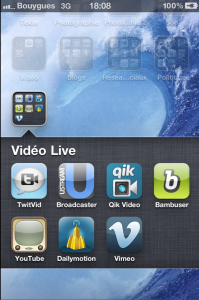 Our cellphones are not only phones anymore, they’re like a small computer that can be used for work. That’s why most journalists are now equipped with one. This way, they are always connected to the Internet and they can at any moment, search for latest news.
Our cellphones are not only phones anymore, they’re like a small computer that can be used for work. That’s why most journalists are now equipped with one. This way, they are always connected to the Internet and they can at any moment, search for latest news.
But above, smartphones can be used as tools. They are recorders and cameras, that can replace proper material for some occasions. Journalists should be multitasks and this devices make it easier. No need to be an expert in video or photography, applications on smartphones are within the reach of everyone.
In addition to the camera included on the phone – that are more performant every day – some applications exist that can be really useful for journalists. This is particularly the case for video editing apps, used by journalists to work on their reports, directly from their touchscreans. For the Iphone, different applications are available, like Splice and iMovie.
And once the video is edited, we can share it with Qik for exemple. A free application from the same editor as Skype, that can also be used to cover live events with its streaming function.
To learn more about those applications and others, and find links to download them, you can go here and here for even more details
There are plenty of mobile applications that are useful for journalists. The Knight Center of Journalism in the America’s blog of the University of Texas at Austin gives you a selection of five apps that every journalist should have.
We know that journalism is constantly changing and faced with new revolutions. And this mobile technology is one for the media.
It’s changing the way to work and the organisation of the redactions. With mobile devices, the journalism landscape is not the same anymore and for field journalists, smartphones have a prominent place in their work
Do we publish news on a phone application the same way as on a newspaper ?
Definitely not. People don’t read news on smartphones like on newspapers or even news sites. That is why medias have to create mobiles versions of their content that can be read with cellphones.
And how to do that ? Sentences and paragraphs should be shorter. Users can consult their news applications at any time but they don’t dedicate as much time as to newspapers. Moreover, it can be difficult to focus on a long text if it’s on a small screen. So journalists have to be able to reveal facts in a short way.
Headlines and subheads are important as well, they need to be really good worked to attract the attention of readers. This is true for newspapers too, but it became even more with the Internet, where information is overloaded.
We can also give a brief summary of the story, that users can read quickly on their phones. The idea here, is to bait people and to push them to read more about an information on an other support, that allow journalists to write a more detailed article, like newspapers or even websites.
An other important issue are videos and photos, they should illustrate the article and published along with the text, because it facilitates the reading. Likewise, they should be put on top of the topic to be easily accessible by mobile viewers.
Smartphones are giving a new life to citizen journalism
The distinct border between who consumes news and who produces it, is gradually becoming thinner. I’m not saying that journalism doesn’t exist anymore because anyone could do it, but that anyone can transmit information and facts. News consumers are often news producers as well. Imagine that you are witness of an unannounced protest or something like that, you’ll probably take photos and put them on the Internet. Thus, you can be considered as a news producer or a citizen journalist.
Online citizen journalism took his first steps with the transition to web 2.0 and with mobile devices, it became easier then ever. Smartphones allow you to take photos, videos and directly post them through the net. It’s fast, easy and free. Moreover, it can usually be seen by a lot of people and even become viral.
Most of the time, people post this kind of news and their own reporting, from their cellphones directly to social networks, like Facebook and Twitter. These platforms are often used for these purposes because they’re so accessible with smartphones applications. No need for much writing, a few words and a photo are enough to transmit a news. Then, people post status updates, notes, photos and videos from events regularly and often before mainstream media.
Therefore, this kind of news can be really useful for journalists. That way a journalist can be everywhere. If he finds something interesting that has been posted by someone in Twitter, he can include it in his own publication. So it can be a new tool for journalists to find information.
Wikipedia: a source for journalists?
Posted by Eric Butticaz in Technology on November 23, 2012
By Eric Butticaz
I’ll start with a quick explanation about the importance of sources for journalists. I’ll then explain why is Wikipedia interesting, how you could use it as a journalist and which points you should care about when using it.
Why are sources important to journalists?
A large part of the journalist’s credibility is built over his usage of reliable sources. Therefore, as journalists we have to be careful in our use of sources.
Actually, online sources have become more and more useful for journalists, because lots of information and facts are quickly published, without any limitation due to size or complexity of information. It can be easily illustrated by pictures or schemes and linked to many other web resources. But a side effect of the use of online sources is that they are easy alterable. It is very easy to intervene on an article and to change it without anybody noticing it.
Stating you have an article to write on a topic you don’t have a clue about, how do you start to collect information about it? Is it still useful to take a trip to the next library or to investigate in your newspapers’ archives, or the modern tools like Internet and online resources can be a good starting point?

Number of articles and contributors on en.wikipedia.org (source: http://en.wikipedia.org/wiki/Wikipedia:About)
The sum of information collected on the participative online encyclopedia Wikipedia seems to be an interesting tool. It is issued in many different languages (list of all Wikipedias in different languages) and contains articles on almost every subject you could think about.
Does it mean that I can spare time and collect information directly from Wikipedia without needing to check them?
I don’t think so, because as soon as I think about Wikipedia, my former teaching is coming back to the surface…
What I was told not to do…
During my former academic formation, I have been strictly warned against using Wikipedia in academic work. Nowadays, in the universities, usage of Wikipedia as a source for students is mostly not recommended, and even sometimes forbidden.[1]
What is often mentioned against the use of Wikipedia in an academic context is anonymity of contributors, (hidden) agenda behind the writing of specific articles, a no more growing number of contributors, or the fact that well informed contributors could be silenced. (The Top 10 Reasons Students Cannot Cite or Rely on Wikipedia lists the top 10 reasons and provides external links to explain in more details the precautions to take before using Wikipedia in academic context.)
Despite the warning against Wikipedia in academic context, let’s look closer into a journalistic point of view.
… and what I could do as a journalist…
I think it is possible to use Wikipedia as a interesting resource as a journalist, but then, it is necessary to be cautious ! I’ll discuss here four important points, 1) the information I need, 2) the agenda behind the article, 3) the discussion about the article and finally 4) if Wikipedia is up-to-date.
1) What information do I need?
First of all, I need to know what I am looking for. Am I just looking for general information about a context, a country or am I searching precise data about population or national budget?
Wikipedia may help you to get a clue about a new subject you have to talk or write about. It could also be helpful to find external references about it because the contributors are requested to cite the sources they use as they write an article on Wikipedia. If you are looking for up-to-date data, it is more interesting to get them on primary sources as governments or national offices (like the Swiss Statistics Office).
2) Is there an agenda behind the article?
A Wikipedia article is supposed to be written on a neutral point of view, containing no original research (i.e. research that is not published or supported by other reliable sources) and being verifiable (i.e. every reader should be able to check the informations in the article). These three points are the basis of the article writing policy on Wikipedia, but it doesn’t avoid vandalism in the articles or approximations. Editors can try to bias their point of view to support their own opinion.
It’s also possible to intervene on an article in order to improve the image of its subject, whether a person or a brand.
- Some recent examples could be evoked. The article about Jean-Pierre Pernaut, the well-known news presenter of the “Journal de 13h” on the French TF1, has been modified many times, sometimes on a rather rough manner, in order to enhance his image.
- The France 2 television program “Envoyé Spécial” revealed on the 8th of November 2012 that an article has been modified by an e-reputation society, working according to the rules of Wikipedia, making the changes not easily noticeable. After a few hours, the Wikipedia community discovered that it was the article about Moncef Belkhayat, a Moroccan politician.
http://www.dailymotion.com/video/xv6ci4_faut-il-croire-en-wikipedia_webcam
(The part about the modification of Wikipedia starts at 20:00)
Be careful when you use Wikipedia, whether as a journalist or as a simple curious person. You cannot assume directly that the article you read is written without a specific agenda!
3) Has the article been discussed?
Wikipedia, based on collaborative editing, has a dedicated interface for the revision of articles, where discussion can take place about the modifications. On this page, it is also possible to see who the contributors are (at least by pseudonyms), and to see if they made many additions or corrections on the Wikipedia article.
An article which has almost not been discussed is not more credible. In facts, fewer contributors tend to offer fewer points of view and a bigger possibility of bias in the article.

Revision history of the University of Neuchâtel page on en.wikipedia.org (print screen: 21st of November 2012)
4) Is Wikipedia always up-to-date?
The informations in the article may not be up-to-date! Using the Revision history allows you to see when the last modifications occurred. The older they are, the more the informations may no be up-to-date! Therefore, be careful before using any data. Always cross-check the informations you may use further with external sources.
Summary
Using Wikipedia is not a mortal sin, as long as you care when using it! Always think that Wikipedia should have a neutral point of view, but that it is not always the fact!
As a last word, let’s introduce Jimmy Wales, the founder of Wikipedia, speaking about Wikipedia for journalists :
“Wikipedia is not to use as a citation, but is a perfect tool to enter a new subject.”
- And you, would you dare to cite Wikipedia in an article?
- Do you think you are able to understand how the discussion page is working?
Further reading on Wikipedia and journalism :
- What Wikipedia is not.
- A sociology student also pointed out in 2009 that some modifications of Wikipedia can stay long enough to be used by journalists in a hurry to write an article about some celebrity’s death, in this case the death of Maurice Jarre, a composer of film musics, and using quotes from Wikipedia without checking the source. Read more about it.
- Usage of Wikipedia banned at the AFP in London. Read more about it.
[1] The University of Lausanne, on its Library webpage for example recommends not using Wikipedia as a source, due to its functioning based on anonymous contributions and with no form of scientific validation. (http://www.unil.ch/bcu/page48632.html, consulted on November 18th 2012).
La tragédie humaine : Comment en parler ?
Posted by violetaferrer in People, Various on November 18, 2012
Camp de Korem. Ethiopie. 1984
« La pauvreté, on s’en remet. La misère c’est une chose atroce, qui coupe les jambes et la tête.
La misère, elle est tragédie » Michel Ragon
Sebastião Salgado : De la réalité à l’art. Né au Brésil en 1944. Photographe engagé, il a parcouru plus de 100 pays pour dénoncer les injustices et présenter la réalité en noir et blanc dans un profond réalisme magique.
Reportage photographique de 1984 à 1985 au Sahel publié dans plusieurs journaux internationaux : L’opinion publique prend connaissance d’une manière inédite de la sècheresse, de l’exode de la population rurale et de la guerre civile provoquée par la famine. Une région qui, encore de nos jours connaît la sous-alimentation extrême. L’organisation des Nations Unies pour l’alimentation et l’agriculture, le FAO fait un appel urgent pour réagir à cette crise alimentaire.
Reportage photographique au Sahel
1984, cette région d’Afrique subit une sécheresse des plus désastreuses ainsi qu’une famine qui tuera plus d’un million de personnes et conduira à l’exode de milliers d’autres. Salgado, un des photographes documentaires les plus célèbres de tous les temps, photographie cette cruelle réalité dans la plus grande beauté artistique. Sa photo «Camp de Korem. Ethiopie » ci-dessus, artistiquement, est un exemple de pièce d’art presque biblique, anachronique, impossible à situer dans un moment historique. Sous cette lumière qui pénètre entre la nature et autour de cet arbre ancestral, se trouvent des centaines de personnes dont la souffrance est immesurable. Les photographies de Salgado ont la caractéristique de réunir deux mondes apparemment opposés : la tragédie et l’art.
Pour connaître sa biographie et tous ses travaux, visiter le site Internet : http://www.amazonasimages.com/
Instrumentaliser la misère pour créer de l’art?
Il y a d’une part, ceux qui revendiquent « l’art pour l’art », postulant l’autonomie de l’art et rejetant tout engagement social ou politique, valorisant ainsi le caractère poétique de celui-ci. D’autre part, il y a ceux qui défendent « l’art pour le changement social » où l’art serait un instrument pour le changement de la société, et par lequel l’artiste est appelé à réagir et être un acteur précurseur de changements.
Salgado explique que ses photographies sont une manière de présenter le monde, dont la réalité n’est pas en noire ou en blanc, mais un amalgame infini de gris. Où parmi la misère, il peut y avoir la beauté et parmi la richesse, il peut y avoir la monstruosité. Salgado explique dans une interview « Dans le monde où nous vivons, nous sommes tous concernés, nous ne pouvons pas fermer les yeux, ne pas participer à un changement, et la photographie est un langage qui nous aide à comprendre le monde, elle n’a pas besoin de traduction, elle est universelle »… . UC Berkeley Graduate School of Journalism présente une conférence dédiée à Sebastiao Salgado où il est question de son art, ses inspirations et sa manière de concevoir et interpréter le monde.
Comment parler d’exil, de faim, de misère dans les médias?
Le mandat, la responsabilité des journalistes est d’être des porte-paroles des plus démuni(e)s, de faire connaître au public des réalités lointaines, et participer à la compréhension du monde. Et pour les plus héroïques, lutter pour un changement social. Aux journalistes, chiens de garde de la société, défenseurs de la démocratie, de la liberté d’opinion, et d’une utopique objectivité, une question se pose : Comment présenter la faim à ceux qui comme vous ont l’estomac bien rempli ?
Salgado a choisi de le faire avec des photographies solennelles. Certains pensent que son travail est abstrait, s’approchant plus du travail artistique que journalistique. D’autres pensent qu’il a une manière propre d’interpréter les faits, générant un impact sur la société, la sortant de son impassibilité quotidienne pour la mener dans un monde où se marient horreur et beauté, avec une subtilité magistrale.
Est-ce qu’il existe une manière correcte de parler de la misère humaine ? Il n’existe certainement pas une manière politiquement correcte de faire. Il existe un protocole, un cadre déontologique à respecter : raconter véridiquement les faits, être rigoureux, faire recours à plusieurs sources, confirmer et contraster les informations etc. Il y a des guides pratiques qui expliquent tout cela. Pourtant, il est plus complexe de choisir la forme, la tonalité, l’émotion, l’angle, la manière de présenter la réalité, la souffrance et joie des autres, surtout quand personne n’aime voir ni entendre parler de la misère.
La famine, sujet d’actualité
Jean Ziegler, rapporteur spécial des Nations-Unies pour le Droit à l’alimentation de 2000 à 2008 explique dans son dernier livre : « Toutes les cinq secondes un enfant de moins de dix ans meurt de faim, tandis que des dizaines de millions d’autres, et leurs parents avec eux, souffrent de la sous-alimentation et des terribles séquelles physiques et psychologiques. Et pourtant, l’agriculture aujourd’hui serait en mesure de nourrir normalement 12 milliards d’êtres humains. Soit près du double de la population » (Destruction Massive, géopolitique de la faim, 2011).
La manière de présenter la tragédie de la famine est sans doute un questionnement obligé : La famine est de loin la principale cause de mort de déréliction dans le monde. Mourir de faim est extrêmement douloureux, une longue agonie qui entraîne des souffrances physiques et psychiques intolérables. Les médias ont donc l’obligation de parler constamment, infatigablement, et de toutes les manières possibles d’une des plus grandes causes de mortalité dans le monde : la faim.
«Aujourd’hui, un enfant mort de faim, est un enfant assassiné » Jean Ziegler.
Si vous souhaitez rester informé à ce sujet, comprendre ou agir pour lutter contre la faim dans le monde, suivez les mouvements : En finir avec la faim ou SOS Faim.
Que pensez-vous des photographies de Salgado ?
Pensez-vous que les médias parlent assez de la famine dans le monde ?
Avez-vous des idées pour lutter contre la faim ?
« El mundo nada puede contra un hombre que canta en la miseria ».
« Le monde ne peut rien faire contre un homme qui chante parmi la misère »
Ernesto Sabato
Violeta Ferrer









